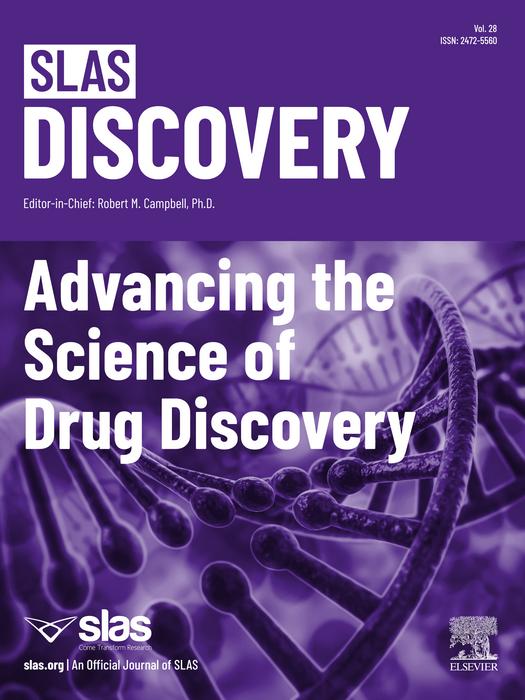Oak Brook, IL – The latest issue of SLAS Discovery is a joint Special Collection between SLAS and the Society of Biomolecular Imaging and Informatics (SBI2) to celebrate the 10th Annual SBI2 High-Content Imaging and Informatics meeting. This collaboration features a curated special collection of articles that highlight the significant impact of high-content imaging in basic and translational research. Volume 28, Issue 7 features one perspective, four original research articles and one short communication.

Credit: SLAS Discovery.
Oak Brook, IL – The latest issue of SLAS Discovery is a joint Special Collection between SLAS and the Society of Biomolecular Imaging and Informatics (SBI2) to celebrate the 10th Annual SBI2 High-Content Imaging and Informatics meeting. This collaboration features a curated special collection of articles that highlight the significant impact of high-content imaging in basic and translational research. Volume 28, Issue 7 features one perspective, four original research articles and one short communication.
Perspective
- Evolution and Impact of High Content Imaging
This perspective highlights the developmental history of high-content imaging up to the latest advancements in cell painting high-content phenotypic profiling. The authors also emphasize the importance of collaborations between academia and industry along with the future outlook for high-content imaging.
Original Research
- FocA: A Deep Learning Tool for Reliable, Near-Real-Time Imaging Focus Analysis in Automated Cell Assay Pipelines
The authors present a special tool, Focal Analysis (FocA), that can check in-focus and out-of-focus images in highly automated high-content imaging pipelines. While FocA is designed to enhance rapid re-imagine and analysis of out of focus assay plates, the authors suggest FocA will benefit the community in both automated and non-automated setups. While FocA is designed to enhance rapid re-imagine and analysis of out-of-focus assay plates, the authors suggest FocA will benefit the community in both automated and non-automated setups. - Automated High-Throughput, High-Content 3D Imaging of Intact Pancreatic Islets
The authors present an assay workflow for high-content imaging of intact islets used to combat the limitations of current islet cell dispersion processes. The research showcases a new pipeline that pairs precise disease modeling with advanced computational techniques. - Characterization of Allosteric Modulators that Disrupt Androgen Receptor Co-Activator Protein-Protein Interactions to Alter Transactivation–Drug Leads for Metastatic Castration Resistant Prostate Cancer
This article is a follow-up to a study that observed the effects of three small molecule compounds on mCRPC, a type of prostate cancer. The efforts of this study aim to provide insight into how these compounds work and their potential benefits for patients. - Novel Beta-Glucocerebrosidase Chaperone Compounds Identified from Cell-Based Screening Reduce Pathologically Accumulated Glucosylsphingosine in iPS-Derived Neuronal Cells
Naito et al. developed a high-throughput screen using fluorescence-labeled GCase inhibitors to identify activators/chaperones for lysosomal beta-glucocerebrosidase, addressing the treatment of Gaucher disease, a prevalent lysosomal storage disorder, and demonstrating the potential therapeutic approach for neurological Gaucher disease.
Short Communication
- MSC.sensor: Capturing Cancer Cell Interactions with Stroma for Functional Profiling
The MSC.sensor platform is used by the authors to explore drug combination therapies. This includes testing combinations that have been clinically proven to be effective, using high-throughput multiwell plate assay formats.
Access to the Special Issue of SLAS Discovery is available at https://www.slas-discovery.org/issue/S2472-5552(23)X0008-2
*****
SLAS Discovery reports how scientists develop and use novel technologies and/or approaches to provide and characterize chemical and biological tools to understand and treat human disease. The journal focuses on drug discovery sciences with a strong record of scientific rigor and impact, reporting on research that:
- Enables and improves target validation
- Evaluates current drug discovery technologies
- Provides novel research tools
- Incorporates research approaches that enhance depth of knowledge and drug discovery success
SLAS (Society for Laboratory Automation and Screening) is an international professional society of academic, industry and government life sciences researchers and the developers and providers of laboratory automation technology. The SLAS mission is to bring together researchers in academia, industry and government to advance life sciences discovery and technology via education, knowledge exchange and global community building.
SLAS Discovery: Advancing the Science of Drug Discovery, 2022 Impact Factor 3.1. Editor-in-Chief Robert M. Campbell, Ph.D., Redona Therapeutics, Watertown, MA (USA)
###
Journal
SLAS DISCOVERY
DOI
10.1016/j.slasd.2023.10.001




